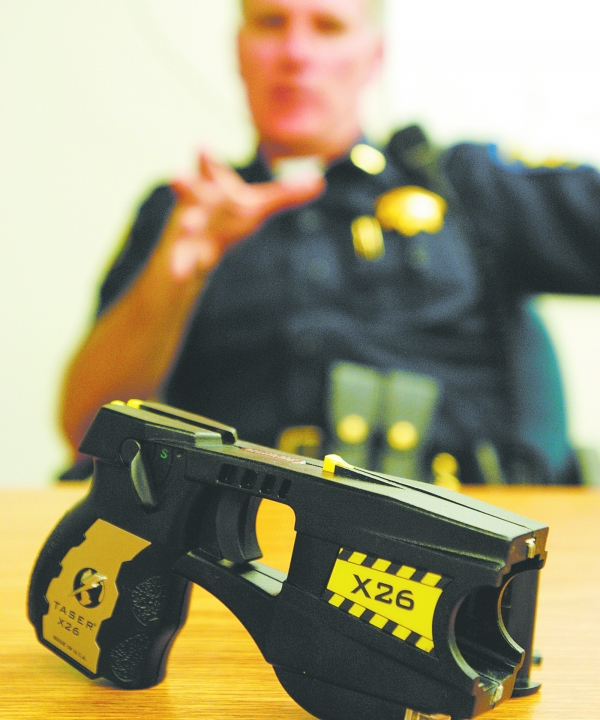Palo Alto's independent police auditors are raising concerns about an investigation involving a man who was pulled over last year for speeding and then engaged in a physical struggle with officers before being subdued with a Taser, according to a new report.
The incident is one of two Taser cases that were reviewed in a new audit by Michael Gennaco and Stephen Connolly, a report that covers the first half of 2016. In both cases, the auditors reviewed the case and the department's investigation before they concluded that the use of Taser was within policy.
But the auditors also had some concerns about the subsequent investigations and recommended that the department "find means to reinforce basic investigative principles with its supervisors" and "enhance its force review protocols to ensure quality control and -- where necessary -- appropriate remediation."
The first Taser incident occurred after officers pulled over a speeding vehicle and discovered drug paraphernalia in the front passenger seat area, according to the report. The officer then decided to arrest the driver, whom he suspected of being under the influence, the report states.
During the arrest, the man reportedly began to struggle with two officers and was eventually taken to the ground, the report states. While on the ground, the man reportedly kicked the police supervisor in the head, prompting him to use the Taser. According to the audit, the struggle then subsided and the driver was handcuffed and taken to the hospital to be treated for abrasions before being arrested.
The auditors confirmed the department's finding that the Taser use was justified and "reasonable." However, they took issue with an officer's comment during the struggle that he was about to "smash" his head into the ground (the comment was captured by the patrol cars's camera system).
They also had some concerns about the officers' interview with the suspect, which took place at the hospital. The officer who used force was present in the hospital room, according to the audit, a circumstance that the audit says can "have a chilling effect on the arrestee."
"The dynamic lessens the likelihood of a full and candid description of his perspective, and therefore impedes the fact-gathering process," the audit states.
In addition, the report notes that while the interview was appropriate, the investigator concluded it with the following questions:
"Is that why you resisted arrest today?"
"When told you were under arrest, you decided to resist?"
"You still resisted, correct?"
The auditors characterized these questions as "leading" questions and note in the report that fact-gathering interviews "are intended to be open-ended and should not suggest the answers to the questions as the investigator did here."
"'Leading' questions are especially problematic when the implied answers are so obviously favorable to the Department, thereby undercutting the objectivity of the process," the audit states. "The impressing from this interview is that the investigator's intent was to obtain a recorded statement in which the arrestee admitted resisting arrest, rather than simply obtaining his version of events."
The second Taser incident reviewed in the audit involved an intoxicated man who was reportedly "passed out" in the bushes in the downtown area. The report states that when the man was approached by officers, he proved "unwilling or unable to secure a ride for himself" to avoid an arrest for public intoxication. When officers then tried to take him into custody, he began to physically resist, the audit states. An officer then warned the man that he would deploy his Taser, according to the report. When the man continued to resist, an officer deployed the Taser and the man stumbled over a trash can, fell to the ground and was handcuffed.
In reviewing the incident and the audio and video recordings, the auditors concluded that the Taser use was appropriate. The officer gave clear warning, the audit states, and the man responded, "You can Tase me all you f---ing want."
The auditors also offered what it called a few "small criticisms" about the department's response. The supervisor's written report on the incident used words like "obviously worsening" and "very dangerous" to describe the struggle terms that the auditors deemed to be "slightly overheated."
"These terms are both subjective and relative, of course, but the recording shows a skirmish with an unarmed and drunk individual that seemed short in duration and mild in intensity," the report states.
The auditors also found that the investigator's interview with the man (who was at the hospital awaiting treatment and still "presumably intoxicated to some extent") appeared to "lack focus," according to the auditors. The man's recollections were ambiguous and the auditors note that the supervisor's line of questioning "did not pin it down as effectively as it might have."



Comments
Leland Manor/Garland Drive
on Mar 31, 2017 at 12:58 pm
on Mar 31, 2017 at 12:58 pm
"While on the ground, the man reportedly kicked the police supervisor in the head, prompting him to use the Taser."
1) From the description, I'm wondering how that happened.
Given that happened as described, was the use of the Taser the best and only way to handle it, or just the most expedient?
2) Was the man on drugs too, or was he just speeding?
3) Anyone would know the best way to interrogate two people is to do so separately, not in front of anyone that was seen as a threat earlier.
4) Overall, I support all police and the PAPD, in particular. But what about all the times when the police cameras are not on, to capture actual events, and for all officers, those that are in the 5-10% that may abuse their power? Just wondering.